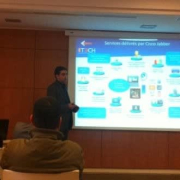What is our primary use case?
Our company is a partner with the solution and we roll it out to clients who have many different use cases.
The solution is one of the go-to products for multi-company, multi-legislative, and multi-location structures. The solution's architecture within the product itself allows you to link to multiple sub-companies within the structure and get a consolidated view. This is the main use case because it allows a consolidated structure to have financial visibility from the higher end or from drilling down to an organization's child level.
We deploy the solution both on the public cloud and on-premises depending on customer use cases. We have about 200 users with 10% to 20% being technical staff and the rest being end users.
What is most valuable?
The best feature is the solution's elastic, multi-company structure. You can expand or add companies at any time while retaining the same architecture and flow with minimal affect on your wallet.
The solution is parameterized so you don't need a lot of customizations because it naturally has the ability to parameterize, configure, and adapt to various organizational procedures. You don't have to stick to some standard way of doing things because the solution adapts to your way of doing things.
The approval and audit engines are very powerful.
The built-in development component allows you to customize and develop without depending on third-party factors. Across six years, 80% to 85% of our use cases are completely managed within the solution because of its architecture.
What needs improvement?
The solution does not have a solid, out-of-the-box API architecture that is supported. Generally, we need to develop on a case-by-case basis. Reporting and extraction options are there but built-in intelligence is not so you need to rely on third parties.
The CRM is pretty basic for collaborating or connecting across departments so it should be enhanced for the next upgrade.
For how long have I used the solution?
I have been using the solution for five or six years.
What do I think about the stability of the solution?
I rate stability an eight out of ten.
What do I think about the scalability of the solution?
The solution is scalable so I rate scalability an eight out of ten.
How are customer service and support?
We contact support, but rarely. We probably contacted them two times last year and three times the prior year.
There is a bit of lag in support due to their decentralized approach. Level one support is in South Africa, level two is in France, and level three is in North America.
This support format is a bit disorganized and that is challenging. Support is rated a four out of ten.
How would you rate customer service and support?
How was the initial setup?
The setup is a little bit difficult because it is not an off-the-shelf solution. It is not like NetSuite where most standard features activate by default. Because of the architecture of the product, not much is standard. You have all the options and need to figure out what the customer wants or needs.
Understanding requirements and needs is a critical factor when using the solution. Otherwise, you will end with a lot of unused options that get obsolete after a while.
Technically, the solution is harder to setup. But if you really understand what you need and plan well, then the solution is going to work for you.
Setup is rated a six out of ten.
What about the implementation team?
We implement the solution for customers. The length of deployment depends on use cases. A vanilla or standard implementation includes the finance and operational modules. The finance side includes the general ledger, payables and receivables. The operational side includes inventory, sales, and procurement cycles. Across this vanilla implementation, there are about 40 mandates and the system provides standard reports. If there are a lot of report modifications or customizations, then you are looking at up to 60 mandates.
If you add the financial distribution module or manufacturing, then you could expect 60 to 70 days for implementation.
We activate a deployment cycle that is pretty similar to what we do with other products. We start with a BRD where we understand the user requirement and get clarity on processes. We align the user in terms of expectations and get sign off. We then move to the prototyping phase.
During prototyping, we ensure that BRD agreements are met and we mock up working models. We go to UAT sessions where we walk through in terms of workshops and onsite meetings to ensure the system meets the initial requirements. We ensure the user gets the full understanding of what was agreed against what was delivered.
Then, we give the user the opportunity to work on the UAT environment for a fixed number of days. During this iterative period, we get feedback and fine tune to align. Once we have confirmation on the UAT environment, we agree on an auto-update and we prepare the balances, templates, and transactions for that update.
Finally, we jump to the go-live phase for transactions. The project team supports the project for some time and then moves it to the support cycle.
What's my experience with pricing, setup cost, and licensing?
The solution delivers the same capabilities of SAP or Oracle at about 30% to 40% of the cost.
Prices are based on a concurrent model and vary depending on the type of user. There are different layers such as full, distribution, finance, and inquiry.
An on-premises license for a full user is about $4,000 plus a 20% annual fee for support. The total for a full user comes to about $4,800 per user, per year.
The lowest level is an inquiry user which runs about $800 per user, per year.
The solution is definitely worth the money. Looking at the capabilities, the full license could be priced better to allow clients to expand. At $4,000 for a full user, the solution is quite expensive compared to other products.
Which other solutions did I evaluate?
We got feedback that SAP and Oracle were not that great overall and not that user friendly.
Our decision was mainly due to budget because there is a huge gap in pricing yet the solution is capable of the same delivery.
What other advice do I have?
It is important to understand the nature and size of your business before using the solution. It is not a tier one product, but is close to it.
If you have a complex, multi-structure operation, then I recommend using the solution. If not, then you might want to look at a tier two product or even a tier one product depending on the ability.
The solution is a very good product in terms of functionality. It has built-in development capabilities and can go to great extent with regard to tailoring for specific needs. It is scalable and works on-premises or in the cloud. It has all the modules and verticals for construction with a built-in approval engine. The solution has all the good things needed for organizational growth either today or tomorrow.
I rate the solution an eight out of ten.
Which deployment model are you using for this solution?
Public Cloud
If public cloud, private cloud, or hybrid cloud, which cloud provider do you use?
Microsoft Azure
*Disclosure: My company has a business relationship with this vendor other than being a customer: Partner





